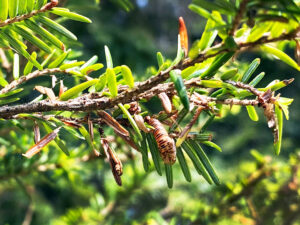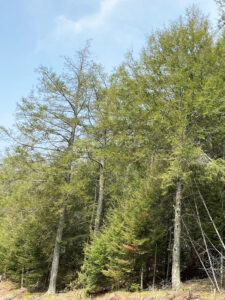
Spruce budworm defoliation this spring on hemlock makes the trees look thin. Photo Credit: Linda Williams, Wisconsin DNR
By Linda Williams, DNR Forest Health Specialist, Woodruff; Linda.Williams@wisconsin.gov or 920-360-0665
Spruce budworm is finished feeding for the year, but the damage from the insects is still being observed.
Spruce budworm prefers to feed on balsam fir and spruce, but a previous newsletter article noted that tamarack had been observed as 100% defoliated by spruce budworm. More recently, stands of hemlock with moderate to severe defoliation were also identified.

Defoliation from spruce budworm makes hemlock trees look thin. Photo Credit: Linda Williams, Wisconsin DNR
Tamarack and hemlock are listed as occasional hosts in the USFS Forest Insect and Disease Leaflet on spruce budworm, so defoliation on these species is not unheard of. Nonetheless, it has not been a common occurrence during the current outbreak in Wisconsin.
Tamarack trees that were severely defoliated by spruce budworm have already begun growing new needles, and many of the hemlock trees also appear to be producing new growth to replace what was damaged or eaten by spruce budworm.
It is unknown how this defoliation will affect the long-term health of hemlock. Because spruce budworm is finished feeding for this year, no treatments are necessary at this time. However, hemlock trees should be monitored next spring for budworm activity.
